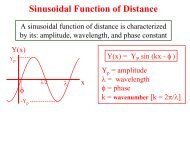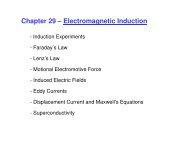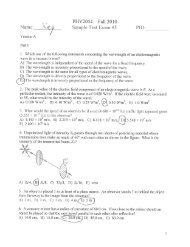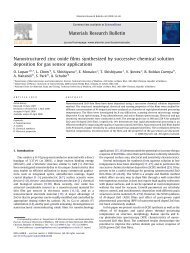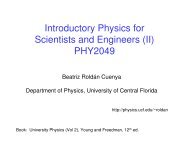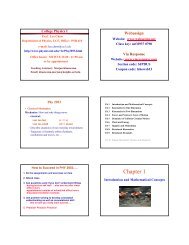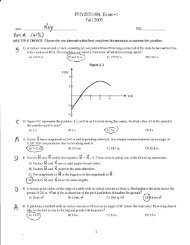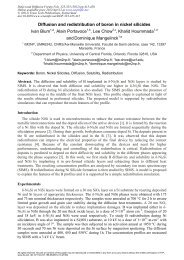Chapter 11 â Equilibrium and Elasticity - UCF Physics
Chapter 11 â Equilibrium and Elasticity - UCF Physics
Chapter 11 â Equilibrium and Elasticity - UCF Physics
You also want an ePaper? Increase the reach of your titles
YUMPU automatically turns print PDFs into web optimized ePapers that Google loves.
<strong>Chapter</strong> <strong>11</strong> – <strong>Equilibrium</strong> <strong>and</strong> <strong>Elasticity</strong><br />
I. <strong>Equilibrium</strong><br />
- Definition<br />
- Requirements<br />
- Static equilibrium<br />
II. Center of gravity<br />
III. <strong>Elasticity</strong><br />
- Tension <strong>and</strong> compression<br />
- Shearing<br />
- Hydraulic stress
I. <strong>Equilibrium</strong><br />
- Definition:<br />
An object is in equilibrium if:<br />
- The linear momentum of its center of mass is constant.<br />
- Its angular momentum about its center of mass is constant.<br />
Example: block resting on a table, hockey puck sliding across a<br />
frictionless surface with constant velocity, the rotating blades of a<br />
ceiling fan, the wheel of a bike traveling across a straight path at<br />
constant speed.<br />
- Static equilibrium:<br />
<br />
P = 0 , L =<br />
0<br />
Objects that are not moving either in<br />
TRANSLATION or ROTATION<br />
Example: block resting on a table.
Stable static equilibrium:<br />
If a body returns to a state of static equilibrium after having been displaced<br />
from it by a force marble at the bottom of a spherical bowl.<br />
Unstable static equilibrium:<br />
A small force can displace the body <strong>and</strong> end the equilibrium.<br />
(1)Torque about supporting edge by F g is 0<br />
because line of action of F g passes through<br />
rotation axis domino in equilibrium.<br />
(2) Slight force ends equilibrium line of<br />
action of F g moves to one side of supporting<br />
edge torque due to F g increases domino<br />
rotation.<br />
(3) Not as unstable as (1) in order to topple it, one needs to rotate it<br />
beyond balance position in (1).
- Requirements of equilibrium:<br />
<br />
P = cte → F<br />
net<br />
<br />
dP<br />
= = 0<br />
Balance of forces translational equilibrium<br />
dt<br />
<br />
L<br />
=<br />
<br />
dL<br />
cte, τ net = = 0<br />
dt<br />
Balance of torques rotational equilibrium<br />
- Vector sum of all external forces that act on body must be zero.<br />
- Vector sum of all external torques that act on the body, measured<br />
about any possible point must be zero.<br />
Balance of forces F net,x = F net,y = F net,z =0<br />
Balance of torques τ net,x = τ net,y = τ net,z =0
II. Center of gravity<br />
Gravitational force on extended body vector sum of the<br />
gravitational forces acting on the individual body’s elements (atoms) .<br />
cog = Body’s point where the gravitational force “effectively” acts.<br />
- This course initial assumption: The center of gravity is at the<br />
center of mass.<br />
If g is the same for all elements of a body, then the body’s Center Of<br />
Gravity (COG) is coincident with the body’s Center Of Mass (COM).<br />
Assumption valid for every day objects “g” varies only slightly along<br />
Earth’s surface <strong>and</strong> decreases in magnitude slightly with<br />
altitude.
Proof:<br />
Each force F gi produces a torque τ i on the element<br />
of mass about the origin O, with moment arm x i .<br />
∑<br />
τ = r ⊥ F →τ<br />
i = xiFgi<br />
→τ<br />
net = τ i =<br />
i i<br />
∑<br />
x<br />
i<br />
F<br />
gi<br />
τ = x F = x ∑ F = τ<br />
cog<br />
g<br />
cog<br />
i<br />
gi<br />
net<br />
x<br />
cog<br />
→<br />
x<br />
∑<br />
i<br />
cog<br />
F<br />
gi<br />
=<br />
1<br />
=<br />
M<br />
∑<br />
i<br />
∑<br />
i<br />
x<br />
i<br />
F<br />
i<br />
gi<br />
x m<br />
i<br />
→x<br />
=<br />
x<br />
cog<br />
com<br />
∑<br />
i<br />
m g<br />
i<br />
i<br />
=<br />
∑<br />
i<br />
x m g<br />
i<br />
i<br />
i<br />
→<br />
x<br />
cog<br />
∑<br />
i<br />
m<br />
i<br />
=<br />
∑<br />
i<br />
x m<br />
i<br />
i
III. <strong>Elasticity</strong><br />
Branch of physics that describes how real bodies deform when forces are<br />
applied to them.<br />
Real rigid bodies are elastic we can slightly change their dimensions<br />
by pulling, pushing, twisting or compressing them.<br />
Stress: Deforming force per unit area.<br />
Strain: Unit deformation<br />
Tensile stress: associated<br />
with stretching<br />
Shearing stress<br />
Hydraulic stress
Elastic modulus: describes the elastic behavior (deformations) of objects<br />
as they respond to forces that act on them.<br />
Stress = <strong>Elasticity</strong> Modulus x Strain<br />
(1) Stress = cte x Strain Recovers original<br />
dimensions when stress removed.<br />
(2) Stress > yield strength S y specimen<br />
becomes permanently deformed.<br />
(3) Stress > ultimate strength S u specimen<br />
breaks.<br />
Tension <strong>and</strong> compression:<br />
Stress =<br />
F<br />
A<br />
( F= force applied perpendicular to the area A of the object)
∆L<br />
Strain = ( fractional change in length of the specimen)<br />
L<br />
F ∆L<br />
Stress = (Young’s modulus) x Strain = E<br />
A L<br />
Units of Young modulus: F/m 2<br />
Shearing:<br />
Stress =<br />
F<br />
A<br />
( F= force in the plane of the<br />
area A)<br />
F<br />
A<br />
= G<br />
∆x<br />
L<br />
Strain<br />
∆x<br />
= ( fractional change in length of the specimen)<br />
L<br />
Stress = (Shear modulus) x Strain<br />
Hydraulic stress:<br />
Stress = Fluid pressure = p =<br />
Hydraulic Stress = (Bulk modulus) x Hydraulic compression<br />
Strain<br />
∆V<br />
=<br />
V<br />
F<br />
A<br />
∆V<br />
p = B<br />
V




